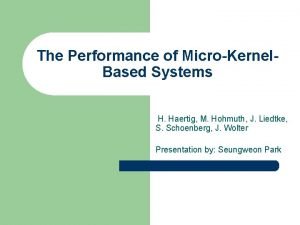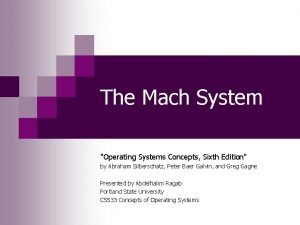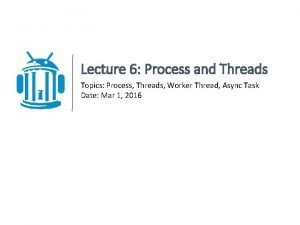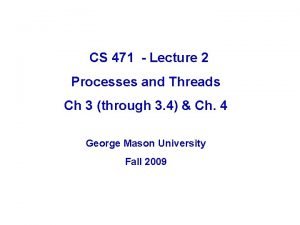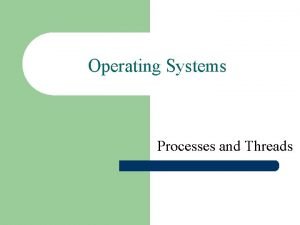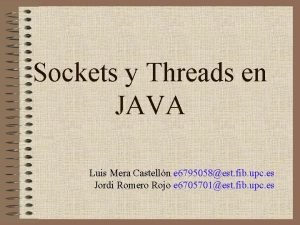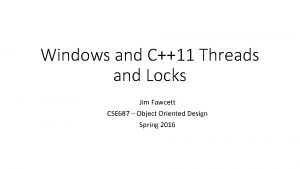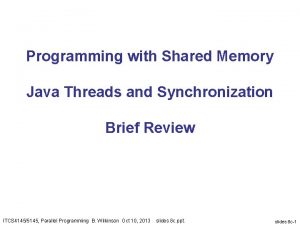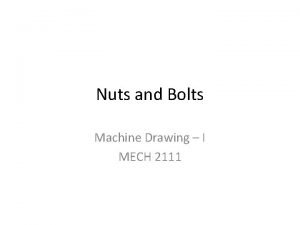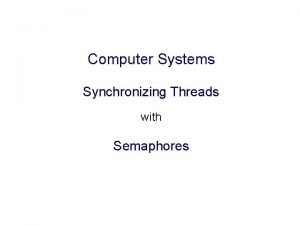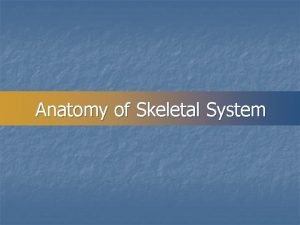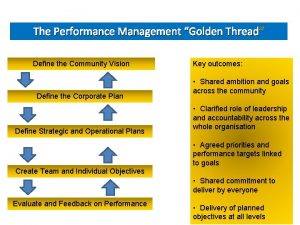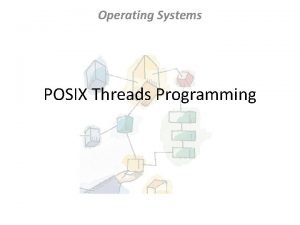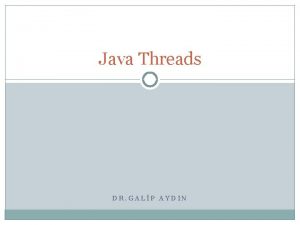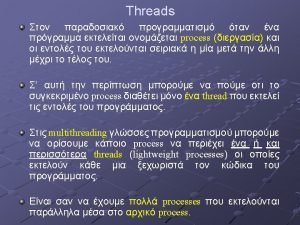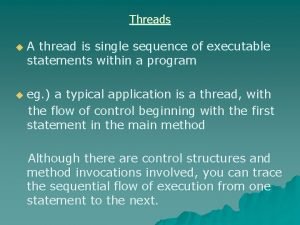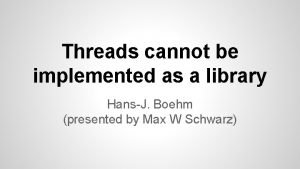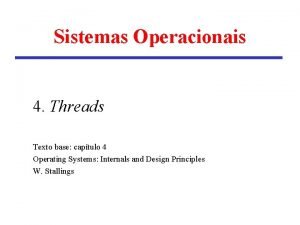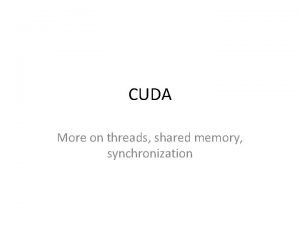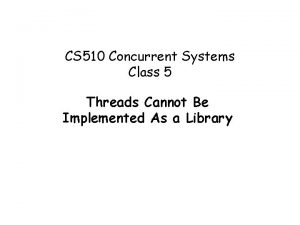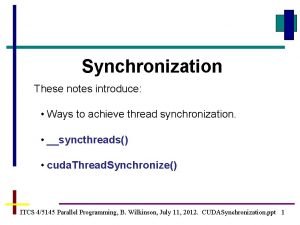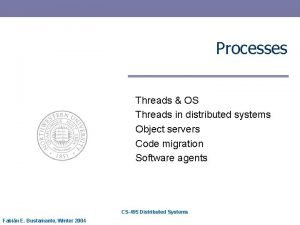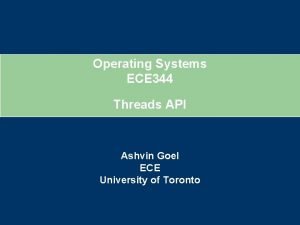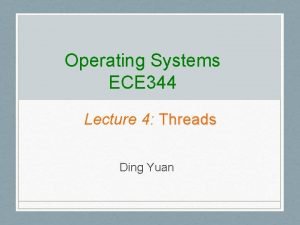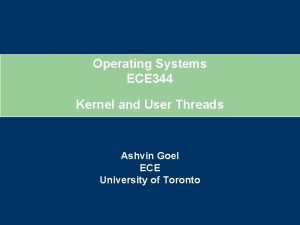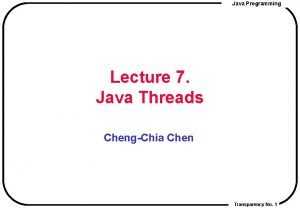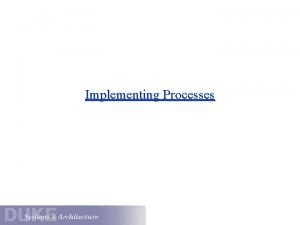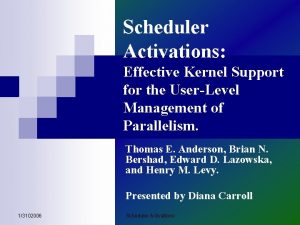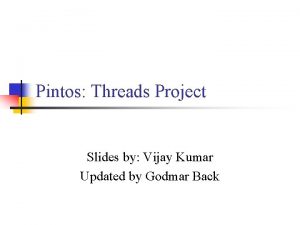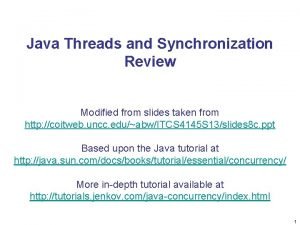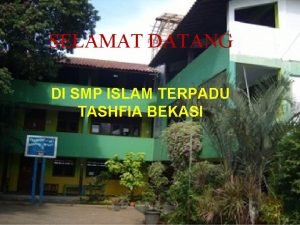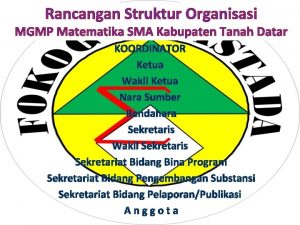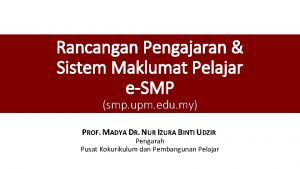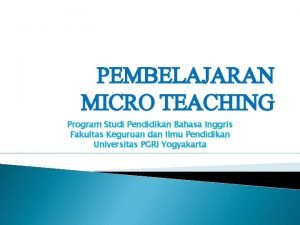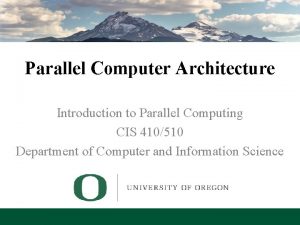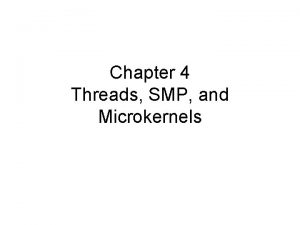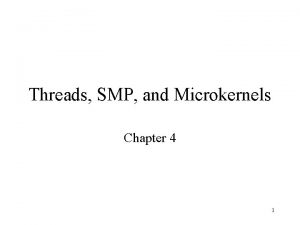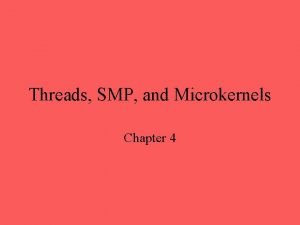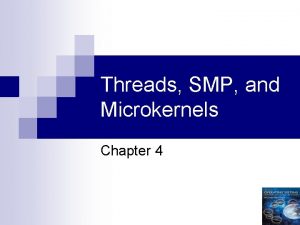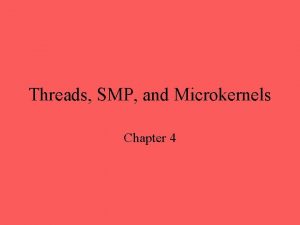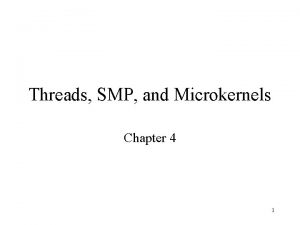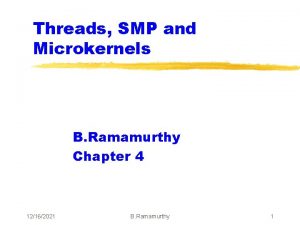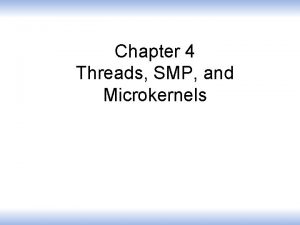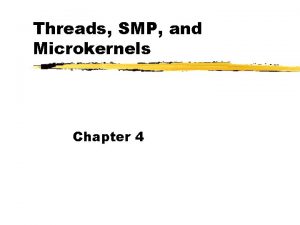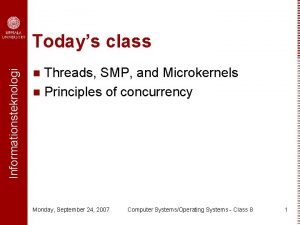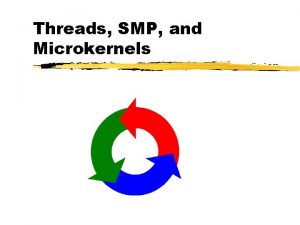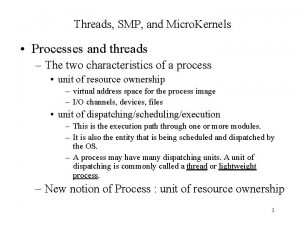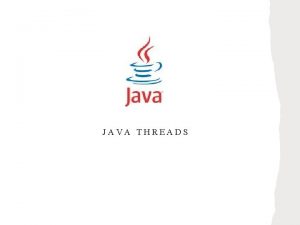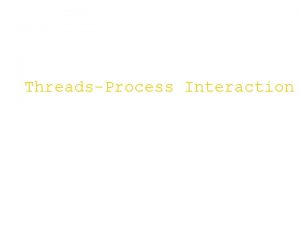Threads SMP and Microkernels Chapter 4 1 Process
























































- Slides: 56

Threads, SMP, and Microkernels Chapter 4 1

Process • Resource ownership - process includes a virtual address space to hold the process image • Scheduling/execution- follows an execution path that may be interleaved with other processes • These two characteristics are treated independently by the operating system 2

Process • Dispatching is referred to as a thread or lightweight process • Resource of ownership is referred to as a process or task 3

Multithreading • Operating system supports multiple threads of execution within a single process • MS-DOS supports a single thread • UNIX supports multiple user processes but only supports one thread per process • Windows, Solaris, Linux, Mach, and OS/2 support multiple threads 4

5

Process • Have a virtual address space which holds the process image • Protected access to processors, other processes, files, and I/O resources 6

Thread • An execution state (running, ready, etc. ) • Saved thread context when not running • Has an execution stack • Some per-thread static storage for local variables • Access to the memory and resources of its process – all threads of a process share this 7

8

Benefits of Threads • Takes less time to create a new thread than a process • Less time to terminate a thread than a process • Less time to switch between two threads within the same process • Since threads within the same process share memory and files, they can communicate with each other without invoking the kernel 9

Uses of Threads in a Single. User Multiprocessing System • • Foreground to background work Asynchronous processing Speed of execution Modular program structure 10

Threads • Suspending a process involves suspending all threads of the process since all threads share the same address space • Termination of a process, terminates all threads within the process 11

Thread States • States associated with a change in thread state – Spawn • Spawn another thread – Block – Unblock – Finish • Deallocate register context and stacks 12

Remote Procedure Call Using Single Thread 13

Remote Procedure Call Using Threads 14

Multithreading 15

Adobe Page. Maker 16

User-Level Threads • All thread management is done by the application • The kernel is not aware of the existence of threads 17

User-Level Threads 18

19

Advantages of ULT’s • Saves overhead of two mode switches • Scheduling can be application specific • Can run on any O. S. 20

Disadvantages of ULT’s • ULT’s executes a system call (Blocking), not only that thread but all the threads within the process are blocked • Multithreaded application cannot take advantage of multiprocessing. 21

Kernel-Level Threads • Windows is an example of this approach • Kernel maintains context information for the process and the threads • Scheduling is done on a thread basis 22

Kernel-Level Threads 23

Advantages of KLT’s • Simultaneously schedule multiple threads from the same process on multiple processors • If one thread is blocked, kernel can schedule another thread of the same process • Kernel routines can be multithreaded 24

Disadvantages of KLT’s • Requires mode switch for thread transfer 25

VAX Running UNIX-Like Operating System 26

Combined Approaches • Example is Solaris • Thread creation done in the user space • Bulk of scheduling and synchronization of threads within application 27

Combined Approaches 28

Relationship Between Threads and Processes 29

Categories of Computer Systems • Single Instruction Single Data (SISD) stream – Single processor executes a single instruction stream to operate on data stored in a single memory • Single Instruction Multiple Data (SIMD) stream – Each instruction is executed on a different set of data by the different processors 30

Categories of Computer Systems • Multiple Instruction Single Data (MISD) stream – A sequence of data is transmitted to a set of processors, each of which executes a different instruction sequence. Never implemented • Multiple Instruction Multiple Data (MIMD) – A set of processors simultaneously execute different instruction sequences on different data sets 31

32

Symmetric Multiprocessing • Kernel can execute on any processor • Typically each processor does selfscheduling form the pool of available process or threads 33

34

Multiprocessor Operating System Design Considerations • Simultaneous concurrent processes or threads • Scheduling • Synchronization • Memory management • Reliability and fault tolerance 35

Microkernels • Small operating system core • Contains only essential core operating systems functions • Many services traditionally included in the operating system are now external subsystems – – – Device drivers File systems Virtual memory manager Windowing system Security services 36

37

Benefits of a Microkernel Organization • Uniform interface on request made by a process – Don’t distinguish between kernel-level and userlevel services – All services are provided by means of message passing • Extensibility – Allows the addition of new services • Flexibility – New features added – Existing features can be subtracted 38

Benefits of a Microkernel Organization • Portability – Changes needed to port the system to a new processor is changed in the microkernel - not in the other services • Reliability – Modular design – Small microkernel can be rigorously tested 39

Benefits of Microkernel Organization • Distributed system support – Message are sent without knowing what the target machine is • Object-oriented operating system – Components are objects with clearly defined interfaces that can be interconnected to form software 40

Microkernel Design • Low-level memory management – Mapping each virtual page to a physical page frame 41

Microkernel Design • Interprocess communication • I/O and interrupt management 42

Windows Processes • Implemented as objects • An executable process may contain one or more threads • Both processes and thread objects have built-in synchronization capabilities 43

44

Windows Process Object 45

Windows Thread Object 46

Windows 2000 Thread States • • • Ready Standby Running Waiting Transition Terminated 47

48

Solaris • Process includes the user’s address space, stack, and process control block • User-level threads • Lightweight processes (LWP) • Kernel threads 49

50

51

Solaris Lightweight Data Structure • • Identifier Priority Signal mask Saved values of user-level registers Kernel stack Resource usage and profiling data Pointer to the corresponding kernel thread Pointer to the process structure 52

53

Linux Task Data Structure • • • State Scheduling information Identifiers Interprocess communication Links Times and timers File system Address space Processor-specific context 54

Linux States of a Process • • • Running Interruptable Uninterruptable Stopped Zombie 55

56
 Microkernel
Microkernel Microkernels
Microkernels Process and threads
Process and threads Process and threads
Process and threads Threads in operating system
Threads in operating system Sockets and threads
Sockets and threads Cliff drainage diagram
Cliff drainage diagram C11 threads
C11 threads Shared memory java
Shared memory java Conventional representation of internal thread
Conventional representation of internal thread Flexible flat material made by interlacing yarns
Flexible flat material made by interlacing yarns Escalonador de processos
Escalonador de processos Os threads
Os threads Vinaya pitaka is a sacred text of
Vinaya pitaka is a sacred text of Needle like threads of spongy bone
Needle like threads of spongy bone Takes out sewing mistakes
Takes out sewing mistakes Golden thread process
Golden thread process Timer_sleep pintos
Timer_sleep pintos Posix threads in os
Posix threads in os Threads java
Threads java Alternanthera red threads
Alternanthera red threads Forum.unity.com/threads/game-over.54735
Forum.unity.com/threads/game-over.54735 Threads fiji
Threads fiji Threads consumes cpu in best possible manner
Threads consumes cpu in best possible manner Posix threads
Posix threads Forum.unity.com/threads/game-over.54735
Forum.unity.com/threads/game-over.54735 Threads vs processes
Threads vs processes Sequence diagram threads
Sequence diagram threads Threads cannot be implemented as a library
Threads cannot be implemented as a library Threads.h
Threads.h In the lathe machine, the workpiece is held by____.
In the lathe machine, the workpiece is held by____. Cuda threads per block
Cuda threads per block Threads cannot be implemented as a library
Threads cannot be implemented as a library Two level model thread
Two level model thread Cuda thread synchronization
Cuda thread synchronization Threads in distributed systems
Threads in distributed systems Ece threads
Ece threads What is thread in operating system
What is thread in operating system Ece threads
Ece threads Chia 3 threads
Chia 3 threads Threads vs processes
Threads vs processes Scheduler activations
Scheduler activations Pintos threads
Pintos threads Joint mission threads
Joint mission threads Threads em java
Threads em java Os threads
Os threads Unlimited virtual smp
Unlimited virtual smp Smp praha 3
Smp praha 3 Smpn 173 jakarta
Smpn 173 jakarta Smp tashfia
Smp tashfia Materi segitiga smp kelas 7 semester 2
Materi segitiga smp kelas 7 semester 2 Deskripsi organisasi mgmp
Deskripsi organisasi mgmp Smp.upm
Smp.upm Smp 3 playen
Smp 3 playen Materi sanlat untuk smp
Materi sanlat untuk smp Teks micro teaching bahasa inggris
Teks micro teaching bahasa inggris Smp architecture
Smp architecture
